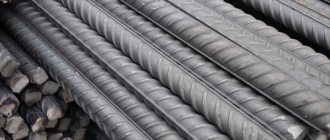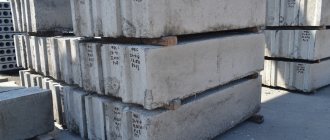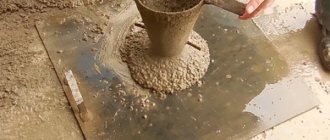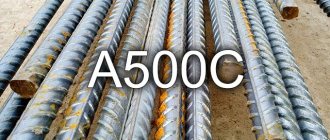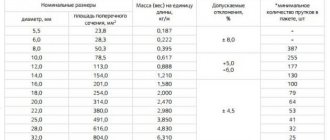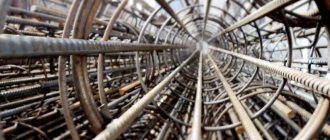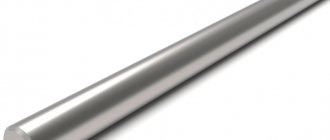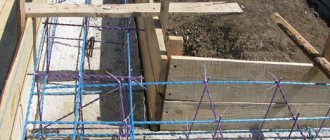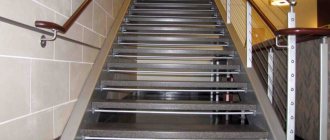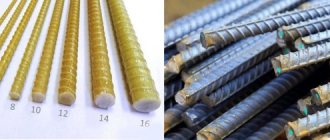Home › Articles › Reinforcement weight 14 mm per meter
In the construction industry, it is often necessary to use high-quality iron base for reinforced concrete structures. High quality fittings are sold here at the best prices; in the catalog you will find fittings of suitable parameters, ranging from 6 mm to 40 mm.
The company cooperates only with proven and reliable manufacturers, therefore it is ready to provide fittings of exceptional quality, with a high level of protection from external factors. The material is used everywhere, in particular for constructing frames that take on the entire load of the structure.
Classification of fittings
During the processing of steel using special equipment, it is exposed to high temperatures. Waste is removed from the steel and special materials are added to increase the strength of the finished rods. These rods are fittings, which have their own scope and specific markings. Manufacturing takes place in accordance with GOST, so you can have no doubt about the quality. You can order the reinforcement at a good price here, and the weight of the 14 mm reinforcement per meter can be selected based on the purpose of use.
There are several types of 14mm reinforcement; it can be smooth or corrugated; it is used where the structure must be as strong as possible. The classification of rolled reinforcement is designated by a special letter A. Hence the difference in price; it will differ depending on the class, batch size, steel grade, and weight of the 14 mm reinforcement. is ready to offer exceptionally high-quality material, it provides a distinction into the following classes:
- A240С – smooth profile;
- A300S, A400S, A500S, A600, A600S – corrugated profile.
At the same time, the letters have their own designations:
- C – means weldable;
- if there is no index, the reinforcement is not weldable.
The difference between class A3 reinforcing steel and class A1
These types of reinforcing steels, manufactured in accordance with GOST 5781-82, have four main groups of differences:
- Dissimilar surface profiles
- all diameters A1 (∅6 mm÷∅40 mm) are manufactured SMOOTH, without longitudinal and transverse grooves. A3, on the contrary, has two longitudinal ribs and projections along helical lines between them. - Various steel grades
are used for production : A3 is made from low-alloy steels with the addition of manganese (35GS, 25G2S), manganese and boron (32G2Rps). For the production of A1, carbon steels (without alloying additives) St3kp, St3ps, St3sp are used. - Various mechanical characteristics
. - The areas of application differ.
A3, thanks to its corrugated surface, has excellent reinforcing properties and is used for reinforcing concrete structures for various purposes in the construction of monolithic buildings and structures made of reinforced concrete (in contrast to smooth A1, which is suitable for reinforcement only in certain, special cases, for example, cylindrical reinforcement cages , for road reinforcement). But class A1 reinforcement is more in demand in the manufacture of auxiliary metal structures (excluding highly loaded ones).
| Reinforcement class | Yield strength kgf/mm² | Relates. length % | Bending test (c - thickness of the post, d - ∅ reinforcement) |
| A-I(A240) | 24 | 25 | c=d |
| A-III(A400) | 40 | 14 | c=3d |
Scope of application
Rebar with a diameter of 14mm is often used in the construction industry for:
- construction of foundations;
- for screed;
- construction of reinforced concrete blocks;
- for the construction of civil and industrial facilities;
- reinforcement of concrete fences.
Reinforcement of 14 diameters is widely used, starting from this parameter, it is supplied not in coils, but in rods. This means that the reinforcement bends well while maintaining strength. Today, this diameter is the most common in the construction industry, because the weight of reinforcement of 14 mm per meter is acceptable, we can also offer reinforcement of 16 mm.
A3 fittings weight table
The table below shows the weight data per linear meter of A3 reinforcement.
The smallest diameter of class A3 rods is 6mm, and the largest is 40mm. Below is a table of the weight of A3 reinforcement.
Note: the numbers in brackets are the mass of the Bp-I rod.
If suddenly you don’t have a table at hand, the weight of the bar can be calculated as follows. First, let's find the volume: 1 m x (0.785 x D x D). In brackets, this is the geometric area of a circle with diameter D and the specific gravity of reinforcement A3, which is equal to 7850 kg/m3.
For example, let’s calculate the weight of class A3 20mm reinforcement. So, volume calculation: 1(m)*(0.785*0.02*0.02) =0.000314 m3. Then the weight: 0.000314*7850=2.4649, which is approximately equal to the value in the table.
History of the emergence of A3 fittings
Initially, since the advent of reinforced concrete structures, reinforcement was not carried out. This technology became possible thanks to the florist from France Joseph Monier, who lived in the period 1823-1906.
Beginning in 1861, he was busy looking for strengthening garden tubs. And already in 1867, on July 16, he received his first patent in this field, which gave a shift in the development of reinforced concrete structures. Over time, scientists and builders took up the baton of his experiments and developments, which significantly improved the characteristics of the frame in reinforced concrete. Today we have A3 reinforcement in the form in which it is presented.
Advantages of 14 mm reinforcement
14 mm reinforcement has a lot of advantages, thanks to which it is widely used. Among them, it is worth noting high strength. The element is manufactured according to GOST requirements and is checked at each stage of production. Easily processed by welding, it is mainly used for the construction of frames.
On the resource it is easy to select suitable fittings, depending on the type of surface. The price per ton is indicated on the website, it starts from 32,000 rubles. Fill out an application using a special form, selecting the appropriate weight of reinforcement 14 mm per meter. The technical parameters of different brands are also indicated, making a choice will be easy. The weight of 14 mm reinforcement per linear meter is approximately 1.21 kg. As a rule, the material is loaded in tons, it contains approximately 828 m. Detailed information is indicated on the website.
Fitting range A3
Products are produced in the diameter range of 6-40 mm. The profile number of periodic profile rods indicates the nominal diameter, which is equal to the diameter of smooth rods of equal cross-sectional area. Rolled products with a cross-sectional diameter of up to 10 mm can be produced in coils or rods, more - only in rods. The coils are formed in such a way that there are no kinks. The length of the segments is 6-12 mm. The rods should not be bent by more than 0.6% of the total length.
Calculation of the mass of a batch of reinforcing bars can be done using a table that presents the theoretical masses of 1 linear meter. They are calculated based on the average density of steel, which is assumed to be 7.85 kg/m3. When multiplying the mass of a linear meter of a product of the corresponding diameter by the total footage, we obtain the weight of the batch.
Table of areas and theoretical weights of 1 m of A3 reinforcement
| Diameter, m | Cross-sectional area, cm2 | Weight 1 m, kg | Diameter, m | Cross-sectional area, cm2 | Weight 1 m, kg |
| 6 | 0,283 | 0,222 | 20 | 3,14 | 2,47 |
| 8 | 0,503 | 0,395 | 22 | 3,8 | 2,98 |
| 10 | 0,785 | 0,617 | 25 | 4,91 | 3,85 |
| 12 | 1,131 | 0,888 | 28 | 6,16 | 4,83 |
| 14 | 1,54 | 1,21 | 32 | 8,04 | 6,31 |
| 16 | 2,01 | 1,58 | 36 | 10,18 | 7,99 |
| 18 | 2,54 | 2,0 | 40 | 12,57 | 9,87 |
To this day, the particularly popular type of fittings on sale with a diameter of 10 mm in A3 (A400) format in accordance with GOST 5781-82 ranges from 40 to 48 thousand rubles per ton. To ensure small volumes of construction, it is better to calculate by footage. 1000 millimeters of reinforcement of the same diameter weighs about 0.61 kilograms. Through accurate calculations you can reach the final amount.
Buy rolled metal at affordable prices
If you intend to order high-quality rolled metal products in Moscow at affordable prices, then this place is the most suitable in this regard. Here you will find 14mm fittings at the most affordable price, and if you need metal cutting specifically for your purposes and dimensions, specialists will provide this for you.
The company works around the clock and is ready to provide competent advice, accept your order, and also take care of delivery using the organization’s transport. You can make payment in any convenient way and also get a nice discount. If you have any questions about the weight of 14 mm reinforcement per meter, or regarding delivery and payment terms, please contact the manager.
Technical characteristics of A3 fittings
Main physical characteristics:
- yield strength – 390 N/mm2;
- temporary tensile strength – 590 N/mm2;
- relative elongation – no less than 14%.
Due to their technical characteristics, A3 class reinforcing bars are used:
- in monolithic construction and production of reinforced concrete products for the production of flat and spatial reinforcement frames;
- for creating metal structures for various purposes;
- for reinforcing floor screeds, paths, blind areas;
- to strengthen road surfaces;
- for the manufacture of gratings, fences, nets;
Types of fittings
Reinforcing bars can be made from:
- fiberglass
- carbon fiber
- hardwood
- basalt plastic
- become
Varieties and their dimensions:
Based on elasticity, GOST divides them into classes:
- A-600 (A4). Diameter from 6-40 mm, steel – 80С, 20ХГ2Ц
- A-400 (A3). Diameter from 6-40 mm, steel – 35 GS, 25 G2S, 32G2Rps
- A-800 (A5). Diameter from 6-40 mm, alloy – 23Х2Г2Т
- A-1000 (A-6). Diameter from 6-40 mm, steel – 22Kh2G2AYu, 22Kh2G2R, 20Kh2G2SR
- A 300 (A2). Diameter from 10-80 mm, steel – St5sp, St5ps, 18G2S, 10 GT
- A-240 (A1). Diameter from 6-40 mm, steel – St3kp, St3ps, St3sp.
There are two more interval hardened varieties:
- A500C. Size 6-40 mm, hot rolled steel
- B500C. Size 6-12 mm, cold-formed
In accordance with the purpose:
- Industrial fittings. Mainly placed lengthwise to prevent the structure from stretching and contracting
- Shut-off valves . Separates the work sphere from the non-work environment.
- Anchor fittings. Driven into the base of the structure for subsequent connection with the main frame
- Mounting fittings. Unites the elements of the entire skeleton of the structure into a complete structural network
- Operating fittings. Installed vertically or vertically, similar to welded rods or clamps. Accepts vertical force, partially performs the function of construction and installation rods
By mood:
- Longitudinal - prevents compression and stretching of the frame and prevents vertical cracks.
- Transverse - strengthening the structure from inclined cracks
By use:
- Stressed - initially subject to change, and therefore becomes much more susceptible to stress. Used for durable buildings
- Non-stressed - not so strong, can be used for buildings where there are no significant loads on the reinforcing mesh.
Five methods of using reinforcement.
Due to the manufacturability of assembly and low cost, reinforcement is widely used in various parts of the construction industry.
- Clamps, hinges. They are used to assemble key links of a building structure in large frames to disperse and absorb the load.
- Reinforced reinforcement frame. The rods are combined by welding seams, using which a “skeleton” is constructed, providing flexibility, rigidity and stability of the load-bearing supports.
- Knitted reinforcement mesh. Used when using small areas of reinforcement, in cases where it is not feasible to combine mesh nodes by welding, during urgent work, or when using reinforcement with iron threads made of non-weldable metals or alloys.
- Base. To strengthen the foundation slab, use longitudinal and transverse placement of rods in a couple of rows (if low, one row is allowed). On average, per 1 meter of longitudinal reinforcement, 1 transverse clamp or rod is installed.
- Reinforced masonry of building walls. Welding reinforcement (knitted), mesh of not very large diameter is used, or individual rods are used, which are placed in the mixture between the rows of masonry.
